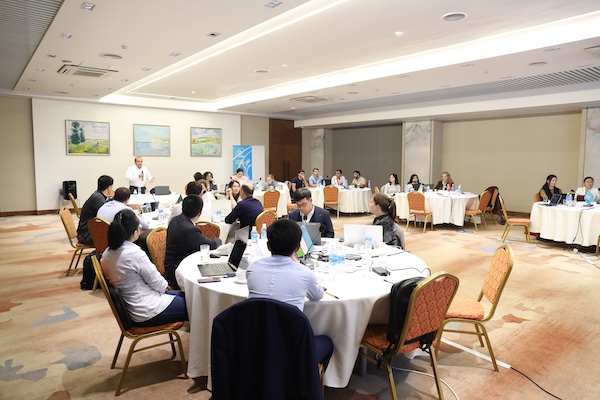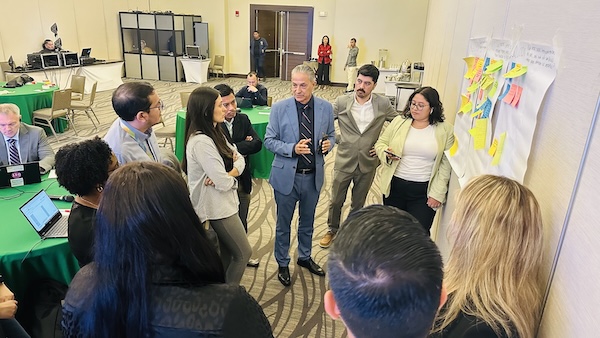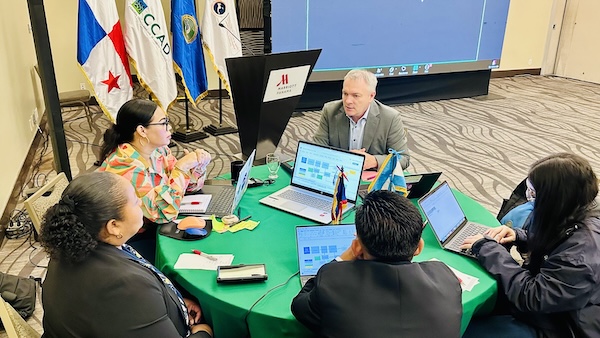
Across the globe, technical experts and policymakers are coming together to strengthen one of the most powerful tools for climate action: the ability to measure and manage their own emissions.
From Port-au-Prince to Bishkek, N’Djamena to Dushanbe, teams of scientists, government officials, and climate practitioners are sharpening their skills to track greenhouse gas (GHG) emissions, assess policies, and strengthen transparency systems. These workshops—led by the GHGMI Consortium (which includes CITEPA) and partners like CAREC, and in collaboration with the Initiative for Climate Action Transparency (ICAT)—are part of a long-term effort to help countries build the technical and institutional capacity needed to manage their climate data independently.
Empowering Experts, Strengthening MRV Systems for Climate Action
For GHGMI, this work is about more than training. It’s about enabling countries to take full ownership of their climate reporting and policy design.
“Our goal is self-sufficiency,” said Matej Gasperic, GHGMI’s Mitigation Program Director. “We aim for every country to be able to assess and report their own data with trust and confidence—not just to meet international requirements, but to empower informed decisions at the national level.”
That spirit of empowerment is reflected in every session, from hands-on modeling exercises to national consultations that lay the groundwork for robust transparency frameworks.
In Haiti, the GHGMI Consortium is supporting the Ministry of Environment as part of a broader effort to build a national MRV (Measurement, Reporting, and Verification)
In Central Asia, GHGMI and Citepa presented at a week-long regional training hosted by the Regional Climate Action Transparency Hub (ReCATH) in Bishkek. The program brought together experts from five countries—Kazakhstan, Kyrgyzstan, Tajikistan, Turkmenistan, and Uzbekistan—to strengthen GHG inventories and assess policies in the land-use sector. Participants learned to track land-use changes, calculate carbon fluxes in forest land and cropland, and quantify emissions using ICAT’s forest methodology and FAO’s EX-ACT tool.
In Tajikistan, Matej Gasperic worked with the Agency for Hydrometeorology and the Committee for Environmental Protection to launch the country’s ICAT Phase II project. This initiative is helping establish a national team to develop GHG projections and evaluate the impacts of policies and measures—critical steps for Tajikistan’s next Nationally Determined Contribution (NDC).
And in Chad, the training (led by CITEPA) supported the country’s efforts to formalize a national MRV agency. This institutional milestone will embed transparency and data-driven policymaking into government systems for the long term.
Learning by Doing: Practical Skills for Real-World Climate Decisions
The defining feature of these workshops is their hands-on approach. Rather than lecture-style sessions, trainers guide participants through real-world exercises—entering data, running models, troubleshooting issues, and interpreting outputs that directly relate to their country’s context.
At the Bishkek workshop, trainers led interactive sessions on the land-use carbon accounting methodology and exercises on quantifying emissions reductions from land-use policies. Participants spent hours comparing the emission-reduction potential of different mitigation measures, identifying national policies to be assessed, and getting a feel for the range of interventions that impact emissions and removals in the forestry and cropland sectors.
“The goal is not just to explain the methodology,” said Olga Lyandres, “but to help participants apply it—to make it part of how they work every day.”
In Haiti, GHGMI’s support for Greenhouse Gas Abatement Cost Model (GACMO) training—a model that allows users to project and compare GHG mitigation scenarios—gave local experts the tools to analyze how policy choices affect emissions and costs. For many participants, this was their first time using such analytical tools directly tied to national decision-making.
“We want people to leave the room not only understanding the theory,” continued Olga Lyandres, “but knowing they can open their laptop next week and actually run the analysis themselves.”
The learning doesn’t stop when the workshop ends. GHGMI and our partner organizations continue to mentor participants remotely, providing feedback and supporting the creation of new data products and reports. It’s a model of sustained learning that builds confidence, not dependency.
A Season of Collaboration: A Global Network Takes Root

In Central Asia, for instance, the regional hub model fosters cross-country learning, with peers reviewing each other’s inventories and sharing best practices. In Haiti and Chad, the creation of new MRV institutions is drawing together ministries, universities, and civil society in ways that have rarely happened before.
“Every workshop becomes a space for exchange—between sectors, generations, and countries,” said Richard Martinez, GHGMI’s Latin America Project Manager and supporter of the Central America ReCATH. “You can see the beginnings of a professional network that will carry this work forward long after the project ends.”
Why Climate Transparency Capacity Building Matters—From National Systems to Global Climate Action
The work of capacity building and ensuring rigorous MRV of emissions isn’t just a technical exercise; it’s a foundational element of credible, scalable climate action across the planet. Without strong capacity and transparent systems, even the most ambitious climate targets risk being undermined by data gaps, low trust, or poor accountability.
Under the Paris Agreement’s Enhanced Transparency Framework (ETF), all parties are expected to submit national GHG inventories, track progress toward their NDCs, and transparently report on support received and needed. Transparent reporting helps build international and domestic confidence, showing that countries are acting on their climate commitments and that investments in mitigation are grounded in reliable evidence.
Better data → Better decisions
When countries can reliably measure their emissions and removals, they can more clearly identify priority sectors, assess the effectiveness of mitigation policies, and make course corrections. MRV systems enable governments to distinguish between working interventions and those that are not, which is crucial for designing policies that deliver real reductions.
For instance, if a national inventory over- or underestimates emissions from the base year used for an NDC target, it may lead to misallocated resources or the adoption of inappropriate mitigation measures. Since climate change is a global challenge, national efforts must be credible, transparent, and comparable to ensure trust among Parties and enable accurate assessment of collective progress. A robust MRV system ensures that national data align with the reporting provisions of the Modalities, Procedures and Guidelines (MPGs), thereby promoting consistency in tracking global progress, aggregating emission trends, and conducting global stocktakes under the Paris Agreement.
Moreover, sustained capacity building is essential for reducing methodological inconsistencies, addressing data and capacity gaps, enhancing institutional arrangements, and reinforcing peer review processes. This continuous improvement strengthens the overall transparency framework and supports countries in achieving and demonstrating their climate commitments.
As the season concludes, GHGMI’s staff have traveled thousands of miles—but the impact is measured not in distance, but in the growing number of national experts who now have the skills to track, model, and manage their countries’ emissions data with confidence.
Looking Ahead: Building Sustainable National Transparency Systems
This whirl of collaboration underscores a fundamental truth: climate transparency begins with people. Each new analyst trained, each database built, each local system strengthened moves the world closer to a future where every country can measure and manage its climate ambition independently.
Through the ICAT partnership, GHGMI’s Consortium is helping make that future real: one workshop, one dataset, one empowered expert at a time.

Comments